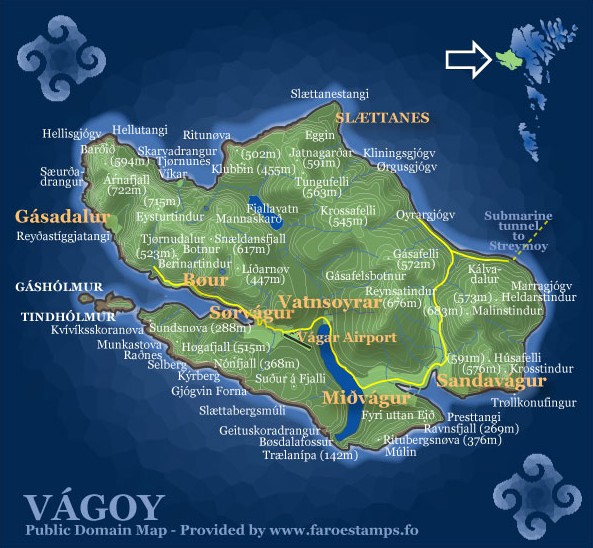|
Skerhólmur
Skerhólmur is a small islet in the middle of Sørvágsfjørður on the island of Vágar, Faroe Islands The Faroe Islands ( ), or simply the Faroes ( fo, Føroyar ; da, Færøerne ), are a North Atlantic island group and an autonomous territory of the Kingdom of Denmark. They are located north-northwest of Scotland, and about halfway bet .... It is uninhabited. Islets of the Faroe Islands Uninhabited islands of the Faroe Islands Vágar {{Faroes-geo-stub ... [...More Info...] [...Related Items...] OR: [Wikipedia] [Google] [Baidu] |
Sørvágsfjørður
Sørvágsfjørður is a fjord on the west side of the island of Vágoy in the Faroe Islands which is approximately long. At the end of the fjord lies the village of Sørvágur. On the northside of the fjord lies the small village of Bøur. On the south side of the fjord lies the picturesque Tindhólmur islet, flanked by the Drangarnir sea stacks and Gáshólmur islet. Roughly in the middle of the fjord lies Skerhólmur. During World War II many British soldiers lived in Sørvágur. Sørvágsfjørður is mentioned in the Pioneers from the WW2 Museum, Krígssavnið, in Miðvágur. The Royal Pioneers who were in the Faroe Islands The Faroe Islands ( ), or simply the Faroes ( fo, Føroyar ; da, Færøerne ), are a North Atlantic archipelago, island group and an autonomous territory of the Danish Realm, Kingdom of Denmark. They are located north-northwest of Scotlan ... from 1941 until the end of the war published their own newspaper. References External links ... [...More Info...] [...Related Items...] OR: [Wikipedia] [Google] [Baidu] |
Vágar
Vágar ( da, Vågø) is one of the 18 islands in the archipelago of the Faroe Islands and the most westerly of the ''large islands''. With a size of , it ranks number three, behind Streymoy and Eysturoy. Vágar region also comprises the island of Mykines. The Vágar island shape is very distinctive, since on maps it resembles a dog's head. The fjord Sørvágsfjørður is the mouth and the lake Fjallavatn is the eye. History Vágar is the first port of call for most foreigners travelling to the Faroe Islands, as it is home to the islands’ only airport, Vágar Airport. An airfield was built there during World War II by the British, who occupied the Faroe Islands with the islanders' consent. After the war it lay unused for about 20 years, but was then put back into service and expanded/modernised as required. It handles about 290,000 passengers a year (2016). Such large numbers by Faroese standards put a considerable strain on transport facilities, with the result that a road ... [...More Info...] [...Related Items...] OR: [Wikipedia] [Google] [Baidu] |
Faroe Islands
The Faroe Islands ( ), or simply the Faroes ( fo, Føroyar ; da, Færøerne ), are a North Atlantic archipelago, island group and an autonomous territory of the Danish Realm, Kingdom of Denmark. They are located north-northwest of Scotland, and about halfway between Norway ( away) and Iceland ( away). The islands form part of the Kingdom of Denmark, along with mainland Denmark and Greenland. The islands have a total area of about with a population of 54,000 as of June 2022. The terrain is rugged, and the Oceanic climate#Subpolar variety (Cfc), subpolar oceanic climate (Cfc) is windy, wet, cloudy, and cool. Temperatures for such a northerly climate are moderated by the Gulf Stream, averaging above freezing throughout the year, and hovering around in summer and 5 °C (41 °F) in winter. The northerly latitude also results in perpetual civil twilight during summer nights and very short winter days. Between 1035 and 1814, the Faroe Islands were part of the Kingdo ... [...More Info...] [...Related Items...] OR: [Wikipedia] [Google] [Baidu] |
Islets Of The Faroe Islands
An islet is a very small, often unnamed island. Most definitions are not precise, but some suggest that an islet has little or no vegetation and cannot support human habitation. It may be made of rock, sand and/or hard coral; may be permanent or tidal (i.e. surfaced reef or seamount); and may exist in the sea, lakes, rivers or any other sizeable bodies of water. Definition As suggested by its origin ''islette'', an Old French diminutive of "isle", use of the term implies small size, but little attention is given to drawing an upper limit on its applicability. The World Landforms website says, "An islet landform is generally considered to be a rock or small island that has little vegetation and cannot sustain human habitation", and further that size may vary from a few square feet to several square miles, with no specific rule pertaining to size. Other terms * Ait (/eɪt/, like eight) or eyot (/aɪ(ə)t, eɪt/), a small island. It is especially used to refer to river i ... [...More Info...] [...Related Items...] OR: [Wikipedia] [Google] [Baidu] |
Uninhabited Islands Of The Faroe Islands
The list of uninhabited regions includes a number of places around the globe. The list changes year over year as human beings migrate into formerly uninhabited regions, or migrate out of formerly inhabited regions. List As a group, the list of uninhabited places are called the "nonecumene". This is a special geography term which means the uninhabited area of the world. * Virtually all of the Ocean *Virtually all of Antarctica *Most of The Arctic *Most of Greenland *Most of The Sahara * Antipodes Islands * Ashmore and Cartier Islands * Bajo Nuevo Bank * Baker Island * Ball's Pyramid * Balleny Islands * Big Major Cay * Bouvet Island * Much of the interior of Brazil * Caroline Island * Clipperton Island * The semi-arid regions and deserts of Australia * Devon Island * Much of Eastern Oregon * Elephant Island * Elobey Chico * Ernst Thälmann Island * Much of Fiordland, New Zealand * Goa Island * Gough Island * Hans Island * Harmil * Hashima Island * Hatutu * Heard Island and ... [...More Info...] [...Related Items...] OR: [Wikipedia] [Google] [Baidu] |


